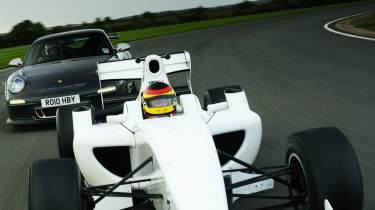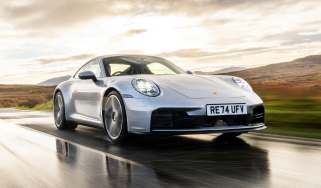Formula 2 racing car v Porsche GT3 RS
What happens when a Formula 2 car laps our Bedford track? Supercars get crushed. Video here
Porsche has truly hit the sweet spot with the current 911 GT3 RS. We’ve never hidden the fact that we’re big fans of the Porsche 911, but there’s no question that this is one of the very best from an exceptional line that stretches back to the first RS of the early ’70s. Its performance in a number of group tests has been outstanding, and if past experience is anything to go by it should be mighty on track too.
Because we’re expecting great things, we thought we’d go lateral for this the track battle and find out just how fast you can ultimately go with similar power to a GT3 RS's 444bhp. We’re talking extreme, the real nth of extreme. We wanted a car designed from the ground up with the sole purpose of lapping a track as quickly as possible, unencumbered by the need for road legality and the annoyance of occasionally having to transport a passenger and luggage. Basically, if a full-on, stripped-out, track-ready 911 is seriously quick around the Bedford Autodrome’s West Circuit – and it will be – just how much faster can you go in a single-seater with similar power (400bhp+) but well under half the weight?
With the 2010 Formula 2 season at an end, we persuaded Jonathan Palmer to lend us one of his centrally run cars for a handful of laps. The car we’re assigned was designed and built by the Williams Formula 1 team, no less. Thing is, you can’t just jump into one of these machines and get going; they’re tailored to fit each driver precisely – the pedals, steering wheel and seat all have to be set just so, and that’s a process that takes around two hours.
When all’s been adjusted, you lower yourself in and assume a position that’s not unlike taking a bath, only with a lot less room and fewer bubbles. You have a pedal under each foot and just enough space to turn the multi-function yoke-like steering wheel. Other than that you cannot move – even the belts have to be done up for you by a friendly engineer, who completes the enclosing process with a head restraint that sits on top of your shoulders. Eventually I’m ready to go, physically if not mentally. I really don’t know what to expect, although the view down the car’s nose between the two slick tyres looks familiar. It’s a 3D version of those on-board camera shots you see on TV every other Sunday afternoon. I’ve never driven a single-seater before and I’ve got quite a large crowd watching my every move. As well as the small army of technicians and staff, the new F2 champion, Dean Stoneman, is here to offer advice, along with JP himself and his son Jolyon, who finished second this year. For comparison, Jolyon will also be setting a time in his own car. No pressure then…
‘You will stall it, everybody does,’ says Stoneman. I prove him right by doing just that. More than once. The clutch is hand-operated via a lever below the gearshift paddles on the back of the wheel. Pull it in, flick the top-right paddle to select first, then release the clutch barely a millimetre to feel it bite. Add revs to get the car moving before smoothly releasing it the rest of the way. Flinch or twitch at any stage during this process and the 1.8-litre Audi turbo engine will stall and die in an instant.
Once rolling, you don’t need to use the clutch again and the pneumatically operated Hewland gearbox is one of the most incredible shifters I’ve ever experienced. Downshifts come with a perfect blip, while the upshifts (accompanied by a crack! and a burst of flame from the exhaust) are so fast the pause in acceleration is imperceptible.
And wow, what acceleration. After a couple of laps to get some heat in the brakes and tyres, I begin to extend it, and when I do the 425bhp fires me down the track much harder than I’ve felt from any road car, despite many of them having in excess of 600bhp at their disposal. I shouldn’t be surprised, for the F2 car weighs just 570kg, giving it a power-to-weight figure of 757bhp per ton – almost as much as the fastest Koenigsegg, the CCXR Edition.
After telling me I’d stall, Stoneman was surprised to see a microphone being attached to the inside of my helmet to allow me to commentate for the video during my run. ‘It’s way too fast to talk and drive,’ he said. He’s right again. I’m so consumed by concentration I don’t utter a single word. There’s a hell of a lot to take in, and due to poor weather earlier in the day and a noise curfew I’m only going to get eight laps – enough time only to scratch the surface of what an F2 car can do.
Left-foot braking is something I rarely do, and although the brakes feel mighty I don’t use them anywhere near hard enough. When I sit down with Palmer Junior after my run for the humbling experience of comparing our data traces, I’ll discover he is way later and harder on the brakes everywhere. At high speed the downforce pins the tyres into the tarmac and braking hard and pitching the nose forward increases that effect further still, giving massive retardation at the beginning of the braking phase. It sounds easy when looking at data, but getting your head around the concept while flying at corners far faster than you ever have before is a different matter entirely.
And it’s that downforce that is the most incredible and difficult thing to come to terms with. I thought I knew the West Circuit, but the F2 car makes the track feel like a completely different place entirely. The invisible downward force finds bumps on previously smooth track, the straights no longer seem to exist and there’s massive, almost spooky levels of extra grip in the high-speed corners.
On each lap I carry more speed through the fast final two turns but I never get close to the limit. On the slow to medium-speed bends I’m close to matching Palmer’s cornering speeds, but on the quick stuff I’m nowhere near. While I’m braking on the approach to O’Rouge and Tower, a mere lift is sufficient for JP.
‘When I first drove an F2 car, I was the same as you,’ he says later, ‘and I’d been racing in FPA single-seaters before moving up. The F2 car has a phenomenal level of downforce and it’s a major step up from some of the national-level formulae.’
My best lap of 1.12.2 is a massive 9.5sec slower than JP, but after studying the data I’m confident I could find whole seconds given more time to adjust. And I do get more time, as a few days later the team invites me back for a second run. The track isn’t in the same condition as it was before, being still slightly greasy after a morning of drizzle, but I immediately feel more at home. That first outing was a blur that was hard to comprehend at the time, but once out of the car I’d been able to take stock and absorb the experience.
This time things aren’t so shocking, so I can feel the Williams working underneath me and explore the limits a little more. Despite the conditions, I go a whole five seconds quicker, which is still some 4.3sec off Jolyon’s time, but at least I’m getting a true understanding of what this amazing machine is capable of.
Back on Planet Earth, I hop into the GT3 RS with the track still not perfect. The fact that the Porsche still feels fast after the F2’s assault on my senses tells you everything you need to know about its outstanding level of ability as a track car. It posts what would by any normal standard be an exceptional time, but it’s still almost 15sec slower around a 1.8-mile lap than the time I posted in the F2 car. Extraordinary doesn’t even begin to cover it.
Lap times:GT3 RS - 1.21.9.
F2 car (RG’s time) - 1.07.3F2 car (JP's time) - 1.03.0




